Research Article
Awareness on Prevention of Complications Related to Immobility among Caregivers of Immobilized Patients of Pokhara
5655
Views & Citations4655
Likes & Shares
Immobility is the state in which individual experiences limitation of physical movement due to critical illness, applications of external devices to body (traction), loss of motor functions etc. Prolonged bedridden and immobilization may lead physiological, psychological, social problems to patient. Pressure sore, deep vein thrombosis, hypostatic pneumonia, constipation, contracture, urinary tract infection, urinary incontinence, muscular weakness, calculi, anxiety, depression etc. are the most common complications occurred due to prolong immobility. The main objective of the study was to assess the awareness level on prevention of complication related to immobility. A descriptive cross-sectional study design was used to conduct the study. Non-probability purposive sampling technique was used to collect data from 172 caregivers of immobilized patients of Pokhara using a semi-structured interview questionnaire. The obtained data was entered on Epi data 3.1 version and transferred into SPSS 20 version for the further analysis. The entered data were interpreted by using descriptive and inferential statistics. The findings revealed that 50.7 % of the caregivers had satisfactory level of awareness, 30.2 % had good level of awareness and only 11 % had poor level of awareness on prevention of complication related to immobility. There were significant association between age (p=0.024), relation with patient (p=0.002) and duration of total number of days with the patient (p=0.001) and awareness level. The study concluded that effective health education programs should be planned and implemented to increase awareness of caregivers regarding preventive measures of complications related to immobility.
Keywords: Awareness level, caregivers, Immobilized patient, Prevention of complications of immobility
INTRODUCTION
Immobility is the state in which individual experiences limitation of physical movement due to different causes like critical illness, applications of external devices to body (traction), loss of motor functions and surgical procedures. Prolonged bedridden or immobilization can lead physiological, psychological as well as social problems such as pressure sore, deep vein thrombosis, hypostatic pneumonia, constipation, contracture, urinary tract infection, urinary incontinence, muscular weakness, calculi, anxiety, depression, isolation from society etc. [1,2].
Family members play important role in providing adequate care to patient. At that time, they also experienced numbers of problems; physical, psychological, behavioral changes as well as economic burden which impact on their daily lifestyle as well their health [3]. All the type of complications of immobility, effects on quality of life. Major and more complex form of complications, decreased more quality of life if adequate care was not provided [4]. Among the complications, pressure ulcer is most common and approximately 1.7 million patients suffer from pressure ulcers worldwide every year. The incidence of Pressure ulcer is higher in developing countries than developed country due to lack of the knowledge and practices [5]. Preventive measures are better as cost for treating pressure ulcer is 2.5 times higher than preventing pressure ulcer [6].
The descriptive study conducted at Bangalore of orthopedic and trauma ward of St. John medical college to assess knowledge and practices about prevention of complication of immobility showed that inadequate knowledge and practices to prevent complications of immobility [7].
The descriptive cross-sectional study conducted in Chitwan Medical College Teaching Hospital of Nepal to study about knowledge of caregivers on preventive measures of complication of immobility concluded that the caregivers had poor knowledge regarding preventive measures [2].
A 3-month prospective multicenter study conducted in China to describe association between major complications of immobility during hospitalization and the patients’ health-related quality of life after discharge found that major complications of immobility were significantly associated with reduced health related quality of life [4].
A descriptive study conducted at National Trauma Center (NTC), Bir Hospital Kathmandu Nepal to find out awareness and practice of caregivers regarding prevention of complications in traction patients revealed that caregivers had inadequate knowledge and practice to prevent complications and need of health education to increase awareness of caregivers before and during the application of traction to the patient [8].
DATA AND METHODS
The research approach used in the study was quantitative approach by using cross sectional research design. The study was conducted in 2019 from 22 January to 5 February among caregivers of immobilized patients from ICU, Ortho and Geriatric ward of Hospitals in Pokhara (Pokhara Academy of Health Sciences, Manipal Teaching Hospital and Gandaki Medical Teaching College and Research Centre. All the caregivers included in this study were 20 years age and above and stayed with patient for at least 6 h per day. Non-Probability purposive sampling technique was used to collect data from caregivers.
The study was carried out after getting approval from IRC, Pokhara University and official permission from Hospitals of Pokhara. Informed verbal and written consent were obtained from each caregiver after explaining the purpose of the study. Time taken for each caregiver for data collection was 15-20 min. Anonymity and confidentiality were maintained throughout the procedure. A Semi structured interview questionnaire was used to collect data which was developed after reviewing related literature and Content validity of the research instrument was established by consultation with research advisor and content expert. The research instrument was translated into Nepali version and retranslated into English language by the bilingual translator to maintain accuracy. The research instrument consisted two parts i.e., socio-demographic data (caregiver and patient) and semi structured questions related to awareness on preventions of complications related to immobility. There was total 28 questions regarding preventions of complications related to immobility with total score 45 in which 6 of them were multiple choice questions.
All collected data was reviewed and checked daily for its completeness, consistency and accuracy. The data was organized, coded, classified and entered in Epi data and transferred in Statistical Package for Social Sciences (SPSS) version 20 for further analysis. Descriptive statistics (such as frequency, percentage, mean, standard deviation) and inferential statistics (chi-square test/ fisher exact test) were used for data analysis. Each correct response for awareness was given 1 score and total score was 45. The total score was converted to percentage for awareness. On the basis of score percentage obtained by the caregivers, awareness level was categorized as Good (≥80%), Satisfactory (60-79%) and Poor (<60%) [8].
RESULTS
The following tables show the results from the data collection conducted and tabulated as per the research method adopted for the study:
Table 1 shows that more than half (54.7%) of the caregivers were female. Nearly two-third (62.2%) of the caregivers were less than 40 years old. More than one third (38.4%) of the caregivers were from upper caste group. Most (94.2%) of the caregivers followed Hinduism. More than half (64.5%) of the caregivers were living in urban areas. Majority (86%) of the caregivers were married. Nearly half (47.1%) of the caregivers were children in relation with the patient.
Table 2 revealed that the maximum number (69) of caregivers had achieved secondary education. More than one third (39.5%) of the caregivers were housewives. Of the total caregivers, 46.6% belong to the lowest quintile and 11.6 % belong to the highest quintile.
Table 3 shows that the maximum number (163) of caregivers had stayed in the hospital for less than 15 days and only one caregiver had stayed in the hospital for more than 30 days. Three fourth (74.4%) of the caregivers stayed with patients for more than 12 h per day.
Table 4 shows that 34.9 % of the patient’s age belong to 56-76 years. More than half (62.2%) of the patients were male. Half (51.2%) of the patients had not received any formal education. More than two-third (69.8%) of the patient’s had less than 6-month duration of illness.
Table 5 illustrates that more than half (58.7%) of the caregivers had satisfactory awareness on Prevention of Complications related to Immobility and only 11 % had poor knowledge.
The data depicted in Table 6 represents the findings of awareness on different components of prevention of complications related to immobility. The highest awareness level was on constipation with 94.5 mean percentage with mean and SD 3.78±0.453 followed by awareness on pneumonia with the mean percentage 87 with mean and SD 6.13±1.029. The lowest level of awareness was in joint stiffness with mean percentage 67.6 with mean and SD 4.06±1.150.
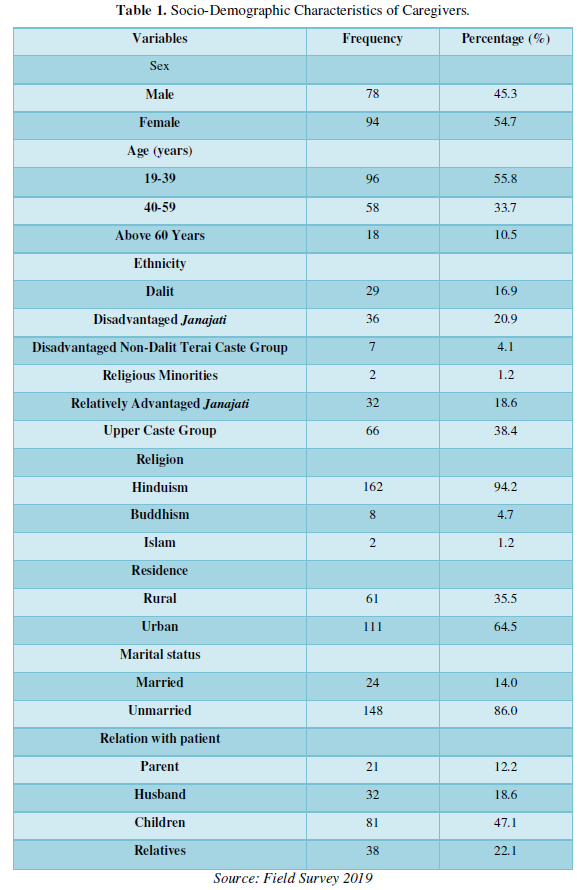
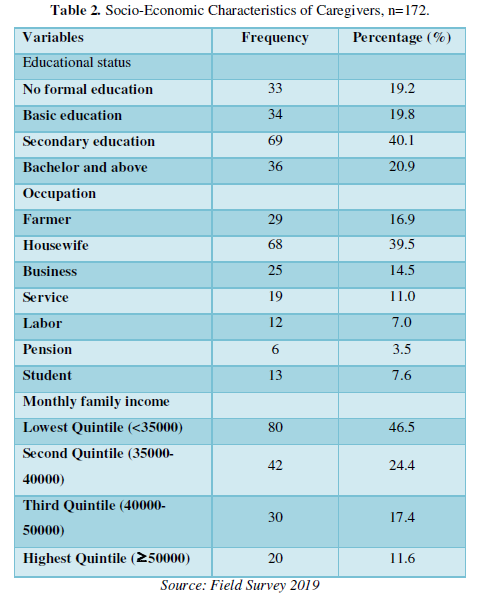
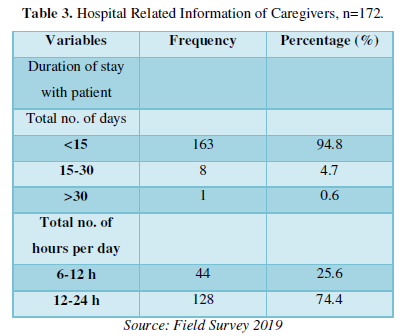
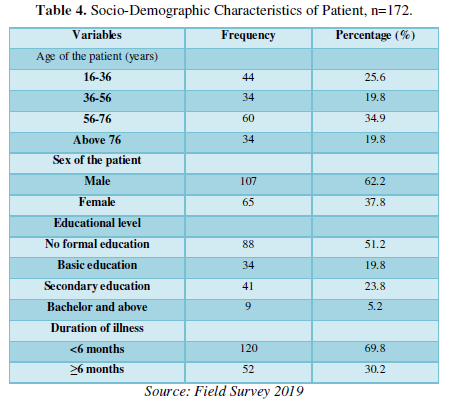

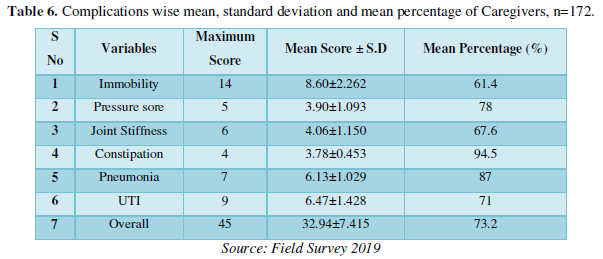
MULTIPLE RESPONSE*
Table 7 illustrates that almost all (97.1%) of the caregivers answered accident and 84.3 % answered chronic illness as the causes of immobility. Regarding the complications of immobility, 82.6 % of the caregivers answered joint stiffness, 58.1 % osteoporosis, 54.1 % orthostatic hypotension, 47.1 % pneumonia, 45.9 % stasis of respiratory secretion, 42.4 % thrombus formation whereas 38.4 % answered osteoporosis and only 15.1 % as urinary incontinence. Similarly, most (98.8%) of caregivers responded to frequent changing positions to prevent pressure sore formation. Regarding breathing and coughing exercise, almost (80.2%) caregivers responded on every 4th h. Majority (85.5%) of the caregivers responded on massaging, 79.1 % on ankle exercise and only 34.9 % on maintaining body weight to prevent joint stiffness.
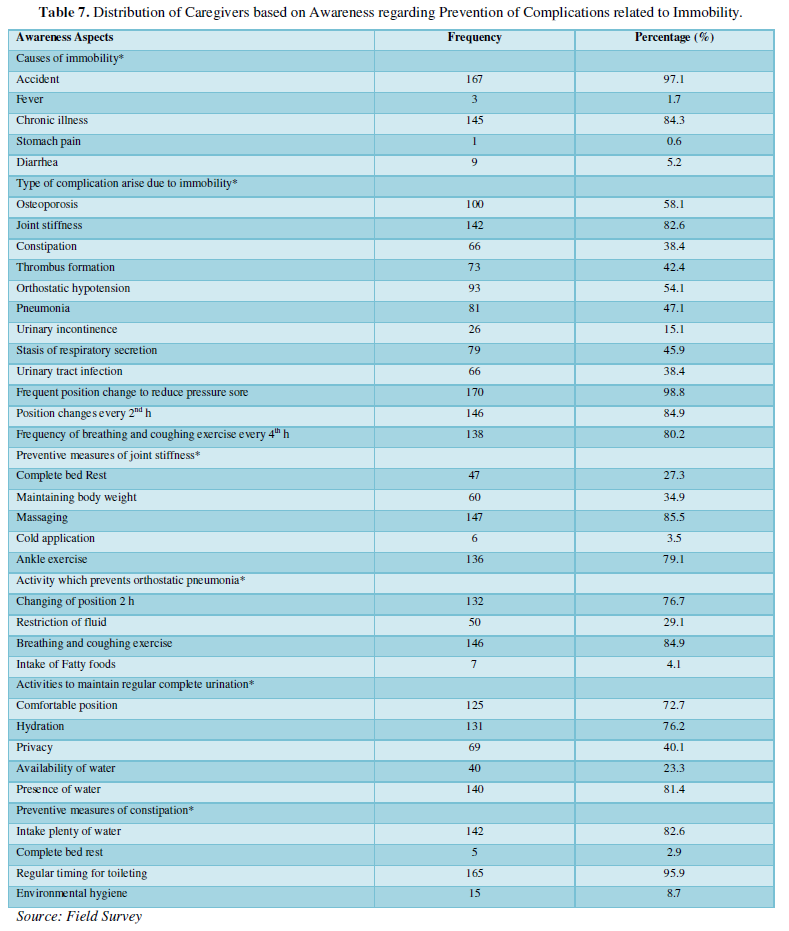

Regarding regular and complete urination to immobilized patients, three fourth (81.4%) of the caregivers responded on need of toilet, 76.2 % on maintenance of hydration, 72.7 % on comfortable position during voiding and only 40.1 % responded on need of privacy. Maximum number (165) of the caregivers responded on regular timing for the toilet and 162 on intake of plenty of water for preventing constipation among immobilized patients.
Table 8 illustrates that the age (p=0.024) of caregiver and relation with the patient (p=0.002) of the participants were found to be significantly associated with level of awareness.
Table 9 revealed that there is no any significance association with socio-economic variables.
Data presented in Table 10 revealed that the total number of days stay with patients was found statistically significant (p=0.001) with level of awareness.
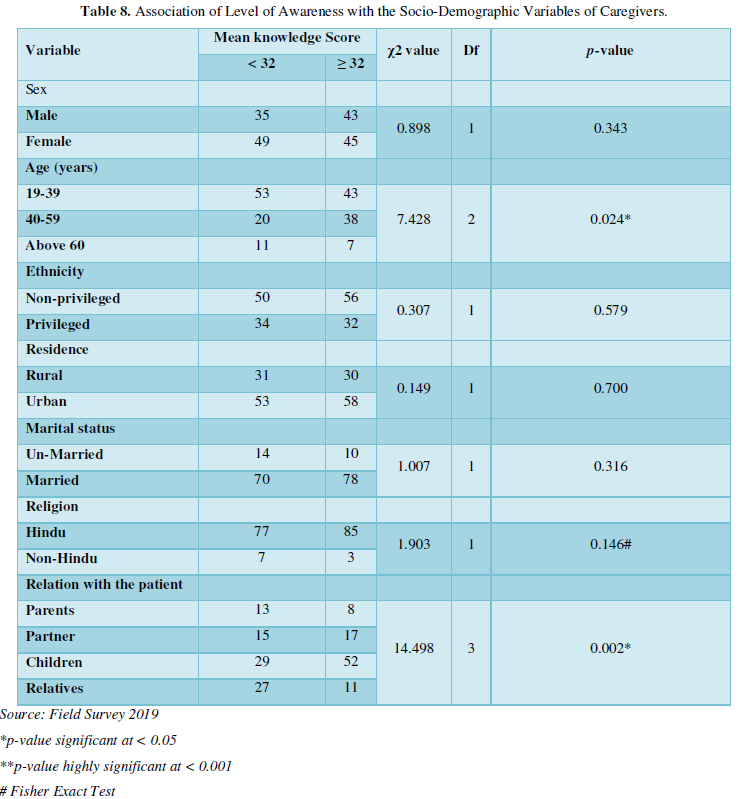
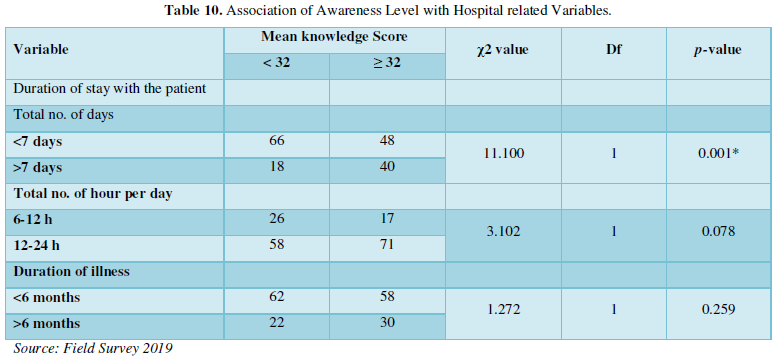


DISCUSSION
The primary aim of this study was to assess Awareness on Prevention of Complications related to Immobility among Caregivers of Immobilized Patients. The study further assessed factors associated with level of awareness on prevention of complications of immobility which includes socio-demographic, socio-economic and Hospital stay related information of the caregivers. The major findings of the study are as follows:
Concerning demographic characteristics, in the present study more than half (55.8%) of the caregivers were between age group 19-39 years and 10.5 % were above 60 years. The mean age of the caregivers was 38.73 years. Regarding sex of caregivers more than half (54.7%) were female and only 45.3 % were male. As regards to the marital status of the respondents, the majority (86%) of caregivers were unmarried whereas only 14 % were married. Maximum number (163) of caregivers had stayed in the hospital for less than 15 days and only one caregiver had stayed in the hospital for more than 30 days. Three fourth (74.4%) of the caregivers stayed with patient for more than 12 h per day. Similar finding was found in the study carried at Bangalore [7]and Chitwan [2].
The present study shows that most (94.5%) of the caregivers knew preventive measures of constipation and most (98.8%) of the caregivers responded on frequent changing position to prevent pressure sore formation. This finding was supported by studies carried at Bir Hospital, Kathmandu [8].
Awareness Related Information
The present study revealed that 30.2 % had a high level of awareness, more than half (58.7%) of the caregivers had satisfactory level of awareness and only 11 % had poor level of Awareness on Prevention of Complication Related to Immobility. The finding of present study was supported by the study carried in Bir Hospital [8].
Awareness on Prevention of Each Complications Related to Immobility
The present study revealed that the highest awareness level was on constipation with 94.5 mean percentage with mean and SD 3.78±0.453 followed by awareness on pneumonia with the mean percentage 87 with mean and SD 6.13±1.029. The lowest level of awareness was in joint stiffness with mean percentage 67.6 with mean and SD 4.06±1.150. These findings are contradictory to the study conducted at Chitwan [2], Egypt [9] and Bangalore [7]. It may be due to the small sample size and different setting.
Association related information
The association of knowledge and baseline variables was done by computing chi-square test. The finding of the study revealed that the association of awareness on prevention of complication related to immobility among caregivers was significantly associated with respondents’ age (p=0.024), relation with patient (p=0.002) and duration of total no. of days with the patient (p=0.001) with awareness level. There is no significant association between Sex, ethnicity, residence, education, marital status, monthly family income, duration of illness and occupation with awareness level.
The present study reveals association on factors age and relation with the patient which is also found in the study carried at Egypt [9]and Kathmandu [8]. The present study also shows association of number of days stays with the patient in hospital with awareness level which was not found in any other studies.
CONCLUSION
The findings of the study concluded that more than half of the caregivers had satisfactory knowledge regarding preventive measures of complications related to immobility. The awareness level of caregivers regarding prevention of complications of immobility is significantly associated with age, relation with patient and total number of days stay with the patient. Therefore, close relatives should be encouraged to give proper care to immobilized patient. Further, effective health education programs should be planned and implemented to increase awareness of caregivers.
ACKNOWLEDGEMENTS
The authors express humble gratitude for the unforgettable support and help provided by of Pokhara University, Hospitals of Pokhara, and caregivers of immobilized patients.
- Mobility and Immobility: NCLEX-RN || RegisteredNursing.org. (n.d.). Available online at: https://www.registerednursing.org/nclex/mobility-immobility/
- Poudyal S, Neupane M, Lopchan M (2014) Knowledge on prevention of complications related to immobility among caregivers of orthopedic patients at selected hospitals of Chitwan district. J Chitwan Med Coll 4(3): 9-12.
- Bevans M, Sternberg EM (2012) Caregiving Burden, Stress, and Health Effects Among Family Caregivers of Adult Cancer Patients. JAMA 307(4): 398-403.
- Wu X, Li Z, Cao J, Jiao J, Wang Y, et al. (2018) The association between major complications of immobility during hospitalization and quality of life among bedridden patients: A 3-month prospective multi-center study. PloS One 13(10): e0205729.
- Kaddourah B, Abu-Shaheen AK, Al-Tannir M (2016) Knowledge and attitudes of health professionals towards pressure ulcers at a rehabilitation hospital: A cross-sectional study. BMC Nurs 15(1): 17.
- Oot-Giromini B, Bidwell FC, Heller NB, Parks ML, Prebish EM, et al. (1989) Pressure ulcer prevention versus treatment, comparative product cost study. Decubitus 2(3): 52-54.
- Kurian J (2005) A study to assess the knowledge and practice of immobilized orthopedic patients and their caregivers regarding prevention of complications related to immobilization in St. John’s medical college hospital with a view to develop a pamphlet. (Thesis). Available online at: http://localhost:8080/xmlui/handle/123456789/2768
- Panta S, Ban RK, Pandey B, Dhita A (2019) Awareness and Practice of Caregivers Regarding Prevention of Complications in Traction Patient. Eur J Pharm Med Res 6(1): 439-444.
- Mersal FA (2014) Caregivers’ Knowledge and Practice Regarding Prevention of Immobilization Complications in El-demerdash Hospital Cairo Egypt. Am J Res Comm 2(3): 78-98.
QUICK LINKS
- SUBMIT MANUSCRIPT
- RECOMMEND THE JOURNAL
-
SUBSCRIBE FOR ALERTS
RELATED JOURNALS
- International Journal of Clinical Case Studies and Reports (ISSN:2641-5771)
- International Journal of Surgery and Invasive Procedures (ISSN:2640-0820)
- Journal of Immunology Research and Therapy (ISSN:2472-727X)
- Journal of Alcoholism Clinical Research
- Journal of Spine Diseases
- International Journal of Anaesthesia and Research (ISSN:2641-399X)
- Ophthalmology Clinics and Research (ISSN:2638-115X)


